| 1 | Olive forest racer |
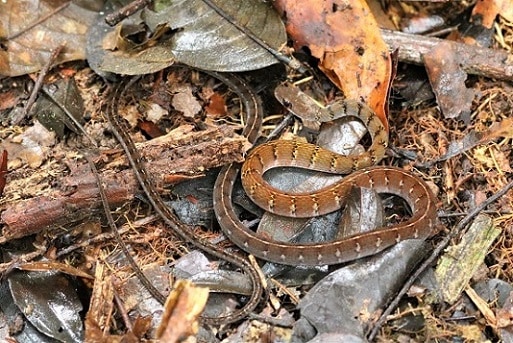
This big-eyed snake lives in the northern Amazon regions, from eastern Ecuador and Peru to northern Brazil. It’s a ground dweller, but will often zip up trees in the blink of an eye. They’re usually encountered crossing forest trails, sprinkled with leaves and greenery.
Olive forest racers have extremely long tails, which go towards one purpose: breaking off when a predator seizes them. Olive forest racers will sacrifice their own tail to allow them to escape, and amazingly, the tail detaches with no bleeding, just a few tiny speckles of blood. The wound somehow seals itself as though cauterised.
This is a frog eating snake, and in the Amazon rainforest, there’s a buffet that never runs dry. One species they eat is Guyana humming frog, which spends much of its time underground, but moves up from March to May to reproduce. The male frogs sit in pools of water making croaking sounds to attract females, but somewhere out there in the jungle, the olive forest racer is also paying attention.
| 2 | American pipe snake |
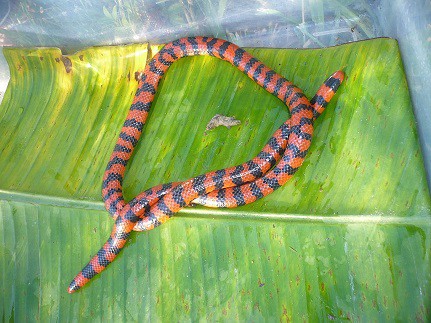
This Amazon snake is isolated on the evolutionary tree. as the sole member of the Anilius family. Its skull is far less evolved, closer to prehistoric lizards, and it has vestigial pelvic girdles in the form of spurs low down on its body, where former legs have disappeared.
Anilius scytale lives deep within the Amazon rainforest. Its colours consist of sharply contrasting orange and black, and its head is barely noticeable. It’s a medium sized snake which can reach 1.2 metres, and has small black eyes. This snake is a semi-burrower, and a large chunk of its diet consists of one reptile: the Bahia slow worm, a burrower itself. They also eat other burrowing snakes, such as Tantilla melanocephala. They’re essentially the lord of a mini burrowing ecosystem, picking on the unfortunate members lower down the food chain.
American pipe snakes are nocturnal and often found on leafy-strewn forest floors, very rarely in trees. They lack venom, and when threatened, they’ll move their tail around rhythmically, showing off the yellow underside, to mesmerise predators. Another primitive feature is jaws that don’t properly unhinge. This snake can’t gape its mouth very wide, and consequently it can only swallow smaller prey.
| 3 | Taczanowski’s dwarf boa |
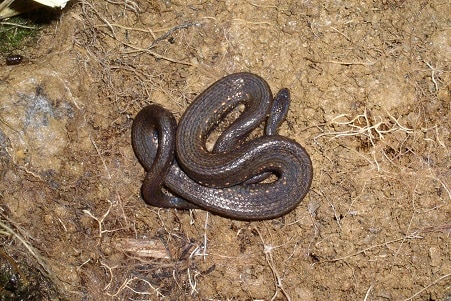
This little known boa is native to the Amazonian slopes of the Andes, covered with dense forests, with a constant mist hanging over. They enjoy elevations of 800-2900 metres, and are very slow moving and lethargic. Their scales have an iridescent sheen, while their bodies are normally a muddy brown with only subtle patterns. They’re only distantly related to the boa constrictor, belonging to the 20-strong Tropidophis family instead.
This is a constricting snake, but unlike the boa constrictor, they mostly eat frogs and tadpoles. Taczanowski’s dwarf boas (Tropidophis taczanowskyi) have a particularly strange defensive trick. Their default is curling up into a tight ball to defend their head, but they also use autohaemorrhaging, spewing blood from their eyes and mouth.
Tropidophis taczanowskyi is incredibly hard to find in its native habitats. Finding four in a day is considered to be great work, and even that’s by researchers flipping over hundreds of mossy logs laboriously. A researcher not looking for them only sees one every 4 months on average. However, this snake isn’t rare, just shy, as most of their pristine Ecuadorian forests habitats are still standing.
| 4 | Royal marsh snake |
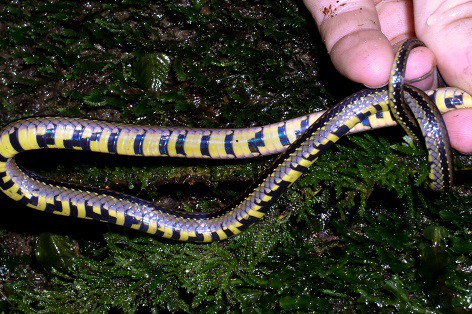
This grand-looking snake sticks to watery zones of rainforests. You’ll find royal marsh snakes (Erythrolamprus reginae) in streams, freshwater springs, and ponds with surface grasses, both in rainforests and rural human zones nearby. They’re found in Brazil, Ecuador, Colombia, Bolivia, Peru, and parts of Venezuela.
Royal marsh snakes have an extremely amphibian-heavy diet, making up over 95% according to one study. One of their top prey species is the frog Physalaemus ephippifer. Frog eggs have also been found in their stomachs. It’s believed that they swim towards tadpoles and swallow up dozens, allowing them to eat very quickly before predators take notice.
Royal marsh snakes like to ambush prey while sleeping. They’re a day-farer while most of their prey is nocturnal, and so they slither around the moist forest floor, with beams of light penetrating down, hoping to find frogs unconscious in their hollows. Erythrolamprus reginae often has green tinges, and their belly is a cream colour with black squares. The eyes sometimes have glints of red.
| 5 | Graceful snail eater |
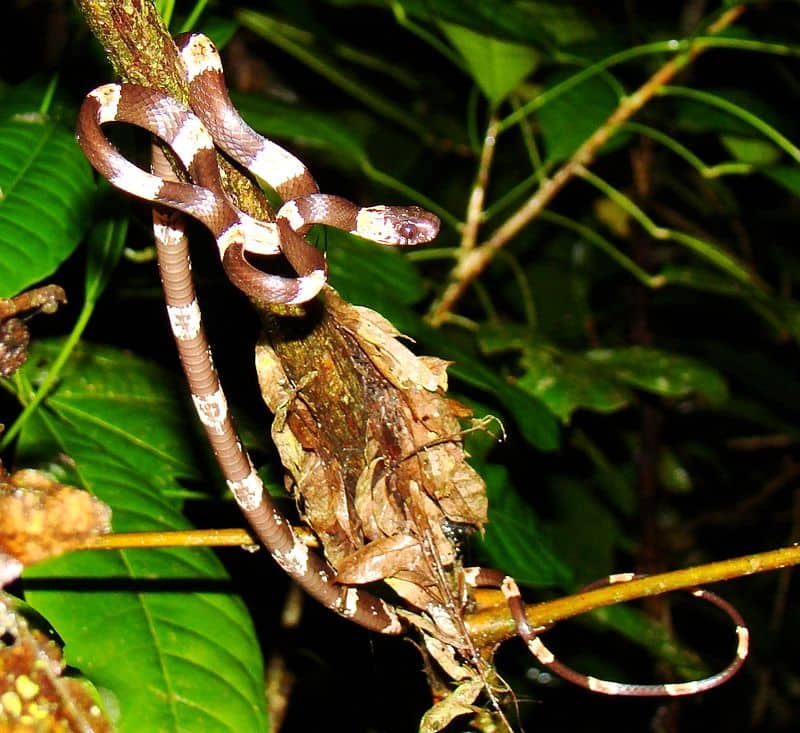
An Amazon snake often found curled up on shrubs 20cm above ground. Nobody knows whether their name comes from their colours or whether they suck down their snails finely like in a banquet. Either way, snails are this snake’s diet, and their technique is gripping the shells firmly and slowly sucking the snail free over many minutes. There are many dipsas snail eater species in south America, but dipsas gracilis is separated from its neighbours by its darker head. They average at 80cm long, and have particularly large, bulging eyes.
The graceful snail eater particularly likes rain and drizzle; precipitation rouses them from their doziness and causes them to get on the hunt. Their temperament might be the graceful inspiration, as this Amazon snake never bites people when scooped up. The most they do is release an intolerable smell.
This is the kind of shy snake that might accidentally vanish without a trace one day, but graceful snail eaters still have a healthy population. Large swathes of their forest are intact in Ecuador and Columbia, and they exist in 21 protected ecological zones.
| 6 | Toad-headed pitviper |
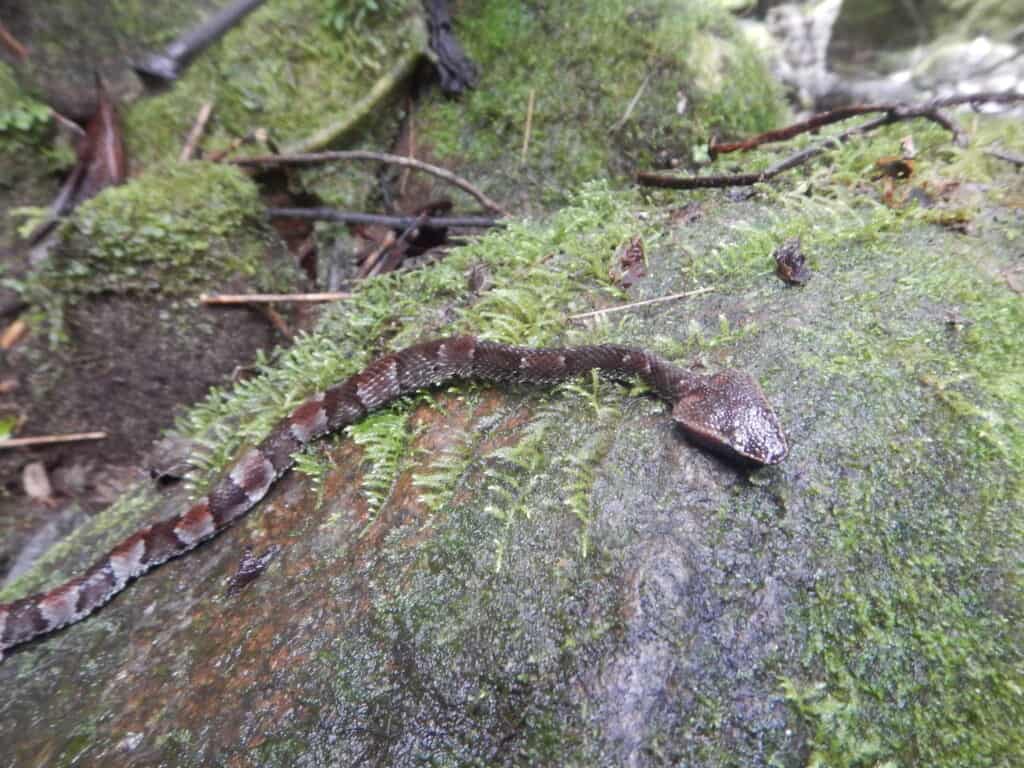
This venomous snake has a massive, triangular head, and equally massive fangs. It’s common in Brazil, Colombia, Ecuador, Peru, and Bolivia, and believed to cause 1.5% of snakebites in certain regions. The toad-headed pitviper is plentiful in rainforests, particularly close to streams and rivers. They also stray into nearby cassava plantations. Data is lacking for this snake, but its close relative B. hyoprora can kill a dog in 2 hours and a child in 7 hours.
Fortunately, toad-headed pitvipers are quite calm, as their camouflage is excellent in fallen leaves. It can take great concentration to spot one in a photograph. Consequently, they assume that they’re safe from attention, but the flipside is that when they do get unnerved, they sometimes attack without warning. Other times they’ll swish their tail from side to side and make a noise in the leaves.
Toad-headed pitvipers are nocturnal, and use ambush to hunt. Their diet is very wide, including frogs, rodents, geckos, and opossums. Recognise them by the X-shaped patterns. The best way to find them (if you have a death wish) is by walking forest trails at night. Often this happens to villagers accidentally.
| 7 | Aquatic coral snake |
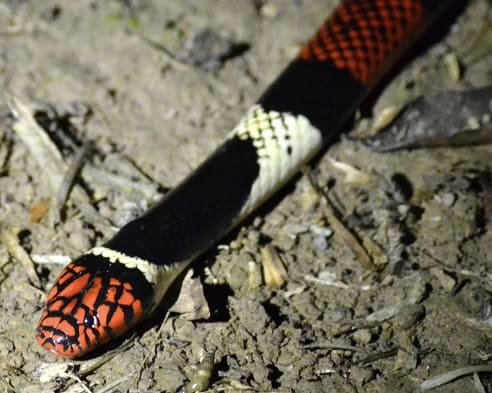
One of South America’s endless coral snake species. However, this snake has a rarity; eyes and nostrils that are oriented upwards, to provide superior sight and smell as they swim. Aquatic coral snakes are actually semi-aquatic, as they usually inhabit streams, lagoons, swamps and slow-moving rivers, but appear in forest floors during the dry season. They also pop up in gardens and houses near the forest border.
Aquatic coral snakes are easy to recognise, with a black and red head. Rather than frogs, aquatic coral snakes feed on fish and eels, which they search for by swimming along the water surface, constantly scanning for any flicker of prey.
Their venom is extremely potent, at LD50 0.2-0.4mg, far outstripping a cottonmouth or copperhead. The symptoms in humans include blurred vision, muscle paralysis and trouble breathing. However, tests have revealed that the venom is specialised against fish, and far weaker in mammals and reptiles. This snake is a focussed machine, optimised for Amazon rainforest rivers.
| 8 | Chironius grandisquamis |
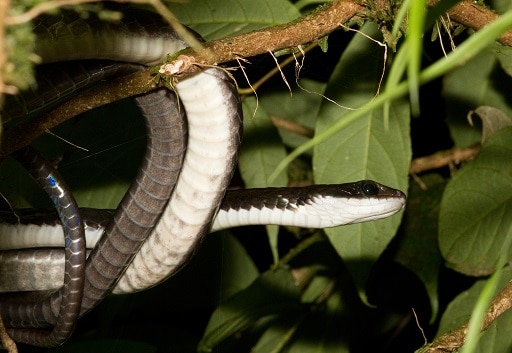
The Amazon rainforest has an endless supply of obscure streams, the sort of shallow rocky streams you can easily cross in your waterproof boots. Look up while in these streams, and there’s a good chance you’ll see Chironius grandisquamis staring down at you. This is a black snake measuring 40cm, beginning life as brown and steadily darkening, with a pristine white belly. Chironius grandisquamis is most often spotted curled up on a thin branch, and their favourite spot is overhanging water. When disturbed by researchers, they sometimes drop off these branches and hide beneath underwater rocks. Chironius grandisquamis can stay underwater for 15 minutes when threatened.
This snake likes humid rainforests with high rainfall. They sometimes rest on branches in pairs, not interacting, but coexisting calmly. Their diet is mysterious, but frogs are confirmed, one species being the northern rainfrog (Craugastor metriosistus). They forage by day, and return to their branches at night.
This rainforest dweller lacks venom, but has several tricks at its disposal. They can flee, bite savagely, or release a foul snake smell to force you to drop them. You won’t see this snake in a hotel lobby; it only lives far from civilisation, in obscure amazon paths that few will ever lay eyes on.
| 9 | Atractus elaps |
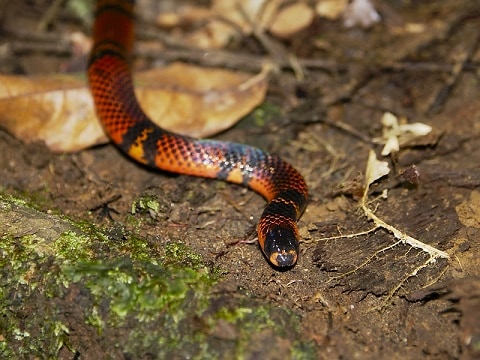
The atractus snake family has over 100 members in the western hemisphere, and atractus elaps is one of the most colourful. This non-venomous snake can inhabit overgrown farm areas next to forests, but are particularly common within rainforests themselves. They’re a small snake at 50cm for males (females slightly shorter), and their body is encircled with vivid red and black rings, occasionally white. Their heads are a shiny black from above, but have a red collar below.
Atractus elaps has a particularly colourful belly, with orange, red and yellow all possibilities. These colours are extremely similar to venomous coral snakes nearby, so it’s believed that this humble snake evolved to mimic them and guarantee a shield. When threatened, atractus elaps will roll up into a ball, protecting the head, and raise the tail high to show off its colours. Two of its common names are Tierrera coral, or the coral ground snake. The disguise is so effective that farmers usually kill them.
This snake is particularly common in the Peru-Brazil border regions. Their main diet is earthworms, and consequently, atractus elaps mainly lives in upper layers of decomposing forest matter, rich in leaves and rotting logs.
| 10 | Machete savane |
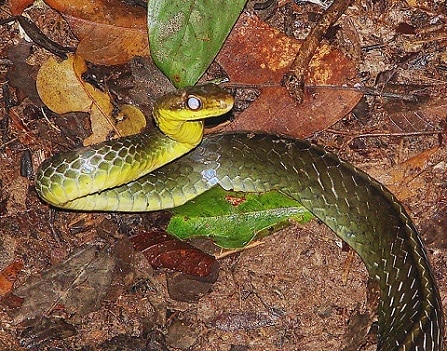
This is quietly one of the Amazon rainforest’s longest snakes. Also called the Amazon whipsnake, it has a very thin body, but can reach lengths of nearly 3 metres. As hatchlings, they’re already 46cm. This is a branch-loving species, so their length makes sense; it probably evolved to make crossing between trees easier.
The machete savane is widespread, found in Brazil, Ecuador, and Costa Rica. Their colours vary, from brown to green-tinged. However, they always have one defining feature: a sharp ridge of scales running down their spine. Machete savanes don’t seem to realise how huge they are, as they often act shy, kinking their long bodies into weird shapes to disguise themselves as sticks on the forest floor. They sometimes grip branches with their tails and dangle their long bodies down like a vine.
When spooked, they might flee into water and top speeds, never to be seen again, but they’re unpredictable, and sometimes lunge forward with a savage (though venomless) bite. Chironius carinatus is also able to inflate its neck like a cobra. These tricks come in use, as machete savanes are sometimes hunted by laughing falcons. This species moves by day, and has a wide diet; birds, reptiles and frogs are all on the table.